Dominique Luchart's Blog, page 737
October 23, 2020
How to buy refurbished gadgets,

Buying a refurbished tech product will save you money compared to buying it new. It also gives a device a second life instead of sending it off to be recycled. And especially during these times when demand is high for all kinds of tech, buying refurbished is sometimes the only way to get your hands on a product when retail channels are strained or just completely out of new merchandise.
Those are all good things — yet “refurbished” is still a loaded word for a lot of people. New means new, a product that nobody else has used. On the other hand, buying something refurbished can be a gamble, despite the fact that the product is probably more affordable.
If it has been refurbished, that likely means the product was either broken or roughed up enough to warrant a repair. It could also mean that whoever bought it simply decided they didn’t want it and returned it to the store. The definition of what makes for a refurbished product varies depending on the seller, though something that may ease some worry is that there are US laws that prevent once-used tech from being sold as new. We’ve seen it in action, too. In 2019, New York City filed a lawsuit against T-Mobile alleging that it had deceived buyers by selling used phones to customers who had paid for new ones.
Still, buying refurbished brings up a lot of questions. Did the original manufacturer refurbish the product, or was it done by a third-party company? Was the product restored to a like-new state, or will it look visibly used when you receive it? Was it professionally cleaned and sanitized, and does it come with new accessories? Does it have a warranty, and who will be accountable if it breaks?
It’s easy to see why a lot of people might prefer to just pay more for something new. However, it’s possible to both save money and not get swindled when buying refurbished products. Below, we’ve laid out some tips that you can follow when buying refurbished tech as well as links to trustworthy retailers. None of this is fail-proof, but it will make the process a lot safer — and you can end up with some great devices at lower prices.
 Photo by James Bareham / The Verge
Photo by James Bareham / The VergeWhat to look for when you want to buy refurbished
In general, if you purchase a refurbished product from its original manufacturer, it’s far less of a gamble than buying from a third-party retailer. The manufacturer is likely to have higher standards for refreshing and repackaging the product, and — crucially — should have access to authentic materials and components. But there are also many companies that exist solely to refurbish products, and they can do a good job, too. You’ll just need to be extra vigilant, ask the right questions, and make sure all of your questions get answered.
In other words, if you’re buying a refurbished product, it helps to have criteria. This will quickly become second nature once you start making a habit of looking at refurbished tech. Here are some questions to start with:
What condition is it in? Is it in like-new condition or somewhat used?
Does it come with all original accessories and documentation?
What kind of warranty does it have, and who is providing it?
The answers to those questions aren’t necessarily obvious. Sometimes, the product might be visibly damaged, come in a different box, or only have a six-month warranty. That’s alright, so long as you know in advance of buying it. In fact, you can often use this info to your advantage to save some money, as resellers may sometimes lower the cost if the product isn’t in perfect condition. You’ll just have to decide what you’re willing to settle for.
What is an open-box product?
Sometimes products will be listed as “open-box.” This term can mean something different depending on the retailer, but most use it to mean that the product was opened by a customer who bought it, then it was returned to the store in its original box with all of its accessories. In other words, it didn’t need to be refurbished because the assumption is that it either wasn’t used at all or was only used once and then repackaged. Generally, it’s safe to assume that an open-box product will in good condition, though it never hurts to ask for clarification or seek the info somewhere on the webpage.
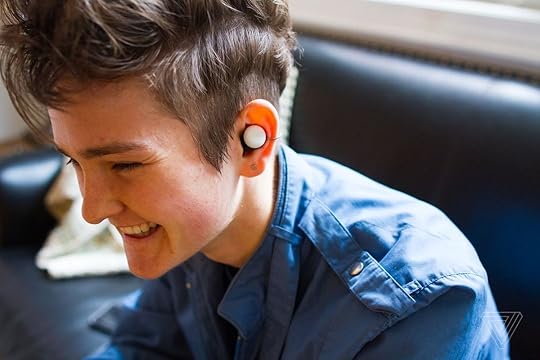 Some people might feel iffy about buying refurbished earphones or other tech products you use in or on your ears.Photo by Becca Farsace / The Verge
Some people might feel iffy about buying refurbished earphones or other tech products you use in or on your ears.Photo by Becca Farsace / The VergeIs there anything that I shouldn’t buy refurbished?
Ultimately, that’s your call to make. Some staffers at The Verge make a sour face at the idea of using refurbished headphones, especially in-ear headphones. I think it’s natural to have that reaction, considering how intimately you would use a product like that. Many, but not all, companies thoroughly clean refurbished products before reselling them. Though, for some people, something that has been used that way is forever unclean.
In my opinion, the most important thing to make sure of when buying a refurbished product is that the warranty is good enough to support you if the device fails. And if the retailer says that your product will arrive in a clean, well-packaged state, make sure that what you receive is representative of their claims.
Update October 23rd, 4:05PM ET: This article was originally published on May 15th, 2020. Several of the entries have been updated, and the second half has been removed to create a new article.
The post How to buy refurbished gadgets, appeared first on NEWDAWN Blog.
Fortnite’s latest Halloween mode turns you into a killer ghost, Jay Peters

 A Fortnite player fighting the new Fortnitemares ghosts. | Image: Epic Games
A Fortnite player fighting the new Fortnitemares ghosts. | Image: Epic Games
Fortnite kicked off its annual “Fortnitemares” Halloween event this week, and this year, you get to play as a killer ghost.
In this year’s Fortnitemares mode, the Fortnite island is packed with spooky touches — a foreboding fog can hang over the island, houses have Halloween decorations, and I’ve even found a witch’s hut surrounded by rideable brooms. But the real twist in Fortnitemares happens when you die: after your untimely demise, you’re returned to the island as a ghost so you can hunt — and troll — the surviving humans.
As a ghost, you can consume materials, health items, guns, and even the Marvel-themed superpowers littered around the map so that the humans can’t use them against you. If you stand still, your purple body…
The post Fortnite’s latest Halloween mode turns you into a killer ghost, Jay Peters appeared first on NEWDAWN Blog.
Fortnite’s latest Halloween mode turns you into a killer ghost,

Fortnite kicked off its annual “Fortnitemares” Halloween event this week, and this year, you get to play as a killer ghost.
In this year’s Fortnitemares mode, the Fortnite island is packed with spooky touches — a foreboding fog can hang over the island, houses have Halloween decorations, and I’ve even found a witch’s hut surrounded by rideable brooms. But the real twist in Fortnitemares happens when you die: after your untimely demise, you’re returned to the island as a ghost so you can hunt — and troll — the surviving humans.
As a ghost, you can consume materials, health items, guns, and even the Marvel-themed superpowers littered around the map so that the humans can’t use them against you. If you stand still, your purple body disappears so you can hide in plain sight (though you can be spotted thanks to your still-visible glowing eyes). Instead of guns, you rely on a set of sharp claws to fight opponents at close range.
But perhaps most importantly, you also have a power that lets you scan for nearby human players. If the scan finds somebody, you’ll see a little red indicator of where they are on your screen and on your map. And crucially, that scan alerts ghosts in your vicinity to the presence of surviving humans, meaning they can join your hunt for the leftover players.
The introduction of the ghosts completely changes the dynamics of a usual Fortnite match. I’m not quite as eager to jump into big firefights as usual, as any player I defeat could return as a ghost to get their revenge. And if I’m one of the last surviving humans, I have to constantly be on alert for dangerous ghost hordes.
I don’t know if I’ll ever be able to survive against all of the ghosts, but I’m having a lot of fun trying. Though when I inevitably die, I love channeling my spookiest ghost self into terrorizing the humans.
The previous Fortnitemares events added zombies and the chance to take down a giant monster, so the opportunity to actually come back from the dead is yet another example of how Epic works to keep Fortnite fresh, even with its annual holiday events. This year’s Fortnitemares event takes place until November 3rd, so you still have some time left to get your ghost on. The game is also celebrating Halloween night by featuring an in-game virtual concert from reggaeton star J Balvin.
The post Fortnite’s latest Halloween mode turns you into a killer ghost, appeared first on NEWDAWN Blog.
SpaceX stacks Starship SN8 prototype ahead of epic test flight, ,

SpaceX’s latest Starship prototype has been stacked in preparation for an ambitious test flight that will take the vehicle far higher than any of its predecessors have gone.
The post SpaceX stacks Starship SN8 prototype ahead of epic test flight, , appeared first on NEWDAWN Blog.
Tesla’s ‘Full Self-Driving’ beta test has caught the attention of federal safety regulators, Andrew J. Hawkins

 Illustration by Alex Castro / The Verge
Illustration by Alex Castro / The Verge
Federal regulators are keeping their eye on the rollout of Tesla’s “Full Self-Driving” experiment. This week, the automaker began beta testing its latest advanced driver assist software with a select group of customers, and so far, the government is taking a wait-and-see approach.
In a statement, a spokesperson for the US National Highway Traffic Safety Administration said it would “monitor the new technology closely and will not hesitate to take action to protect the public against unreasonable risks to safety.” The statement also included some footnoting of Tesla’s decision to describe its driver assist feature as “self-driving” (emphasis ours):
“As we have stated consistently, no vehicle available for purchase today is capable of…
The post Tesla’s ‘Full Self-Driving’ beta test has caught the attention of federal safety regulators, Andrew J. Hawkins appeared first on NEWDAWN Blog.
Tesla’s ‘Full Self-Driving’ beta test has caught the attention of federal safety regulators,

Federal regulators are keeping their eye on the rollout of Tesla’s “Full Self-Driving” experiment. This week, the automaker began beta testing its latest advanced driver assist software with a select group of customers, and so far, the government is taking a wait-and-see approach.
In a statement, a spokesperson for the US National Highway Traffic Safety Administration said it would “monitor the new technology closely and will not hesitate to take action to protect the public against unreasonable risks to safety.” The statement also included some footnoting of Tesla’s decision to describe its driver assist feature as “self-driving” (emphasis ours):
“As we have stated consistently, no vehicle available for purchase today is capable of driving itself. The most advanced vehicle technologies available for purchase today provide driver assistance and require a fully attentive human driver at all times performing the driving task and monitoring the surrounding environment. Abusing these technologies is, at a minimum, distracted driving. Every State in the Nation holds the driver responsible for the safe operation of the vehicle.”
Tesla has a checkered history with the NHTSA, the federal agency that can issue recalls and investigate automobile crashes. In 2019, NHTSA opened an investigation into complaints about vehicle fires connected to the battery management systems in some Model S and X vehicles. The agency has also investigated multiple fatal crashes involving Autopilot. Earlier this year, the National Transportation Safety Board concluded that the advanced driver assistance system was one of the probable causes of a fatal 2018 crash, in which a California man was killed after his Model X smashed into a concrete barrier.
“Full Self-Driving” is an $8,000 (and soon to be $10,000, according to Elon Musk) option that allows Tesla owners to use the vehicle’s previously highway-only “Navigate on Autopilot” function on city and residential streets. The car will stop at intersections, perform left- and right-hand turns, and lane change automatically, as long as the driver has selected a destination in the navigation.
Tesla warns that drivers need to keep their eyes on the road and hands on the wheel at all times — though the automaker famously refuses to include a robust driver-monitoring system (like infrared eye tracking) to ensure its customers are following safety protocols. As such, Full Self-Driving is only considered a Level 2 “partially automated” system by the Society of Automotive Engineers’ standards. NHTSA characterizes it as “Autosteer on city streets,” using the branding for Tesla’s lane-keep assistance feature.
Musk has mischaracterized it as “Level 5” despite no Level 5 system existing anywhere in the world right now.
The post Tesla’s ‘Full Self-Driving’ beta test has caught the attention of federal safety regulators, appeared first on NEWDAWN Blog.
PS5 DualSense unboxing reveals Android and PC support, Jay Peters
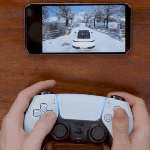
[image error]
You might have seen that many journalists have just received PlayStation 5 units for review, but today we also got our closest look yet at the PS5’s new DualSense controller thanks to an unboxing video from YouTuber Austin Evans.
We already knew that the DualSense has some familiar PlayStation hallmarks — a D-pad and four face buttons on the top half, two analog sticks on the bottom half, four triggers, and, like the PS4’s DualShock 4, a touchpad in the middle — and Evan’s video gives a good look at all of those features and the controller’s new design.
But Evans didn’t use the controller with a PS5, so we don’t get to see things like the DualSense’s new haptic feedback and adaptive triggers in action. And despite the DualSense’s box…
The post PS5 DualSense unboxing reveals Android and PC support, Jay Peters appeared first on NEWDAWN Blog.
PS5 DualSense unboxing reveals Android and PC support,
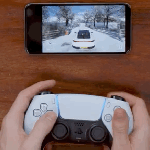
You might have seen that many journalists have just received PlayStation 5 units for review, but today we also got our closest look yet at the PS5’s new DualSense controller thanks to an unboxing video from YouTuber Austin Evans.
We already knew that the DualSense has some familiar PlayStation hallmarks — a D-pad and four face buttons on the top half, two analog sticks on the bottom half, four triggers, and, like the PS4’s DualShock 4, a touchpad in the middle — and Evan’s video gives a good look at all of those features and the controller’s new design.
But Evans didn’t use the controller with a PS5, so we don’t get to see things like the DualSense’s new haptic feedback and adaptive triggers in action. And despite the DualSense’s box only listing compatibility with the PS5, Evans did manage to connect the controller with a wire to a Surface Laptop Go and wirelessly to a Google Pixel 5. He was even able to play a game on Microsoft’s xCloud cloud gaming service on the Pixel.
Evans’ PlayStation 4 Pro recognized DualSense over a wired connection, but the controller didn’t seem to be able to do much on the PS4 Pro except pick up noises from its onboard microphone. The PS4 Pro also seemed to recognize the DualSense as a wireless controller, but it didn’t look like the controller could do anything while connected wirelessly. Evans also tried plugging the DualSense controller into an Xbox Series X, but it was only able to charge.
Evans also took apart the DualSense, giving a look at the circuitry inside the controller and revealing that it has a 1,560mAh battery.
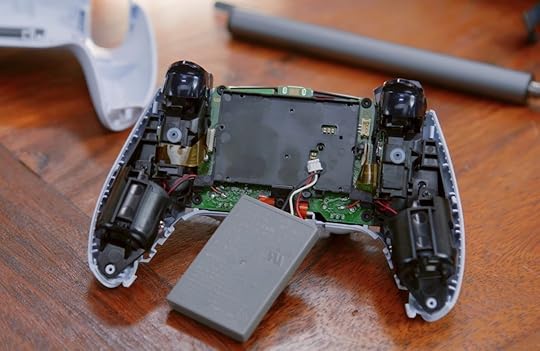 The inside of the DualSense controller.Image: Austin Evans (YouTube)
The inside of the DualSense controller.Image: Austin Evans (YouTube)And in one particularly cool detail, Evans found that there are little bumps on the back of the DualSense that are actually minuscule versions of the PlayStation’s triangle, square, circle, and cross face buttons.
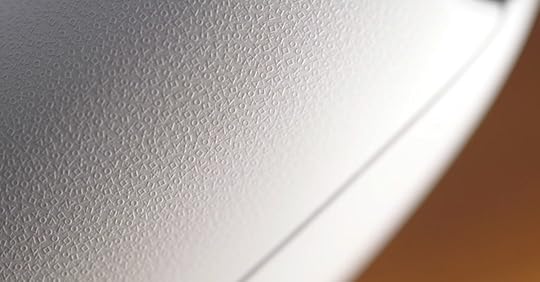 The PlayStation face button shapes on the back of the DualSense.Image: Austin Evans (YouTube)
The PlayStation face button shapes on the back of the DualSense.Image: Austin Evans (YouTube)Overall, the DualSense looks like a good update to the trusty DualShock 4, and I can’t wait to get my hands on one myself when my preorder arrives. The DualSense and the PlayStation 5 officially go on sale on November 12th.
The post PS5 DualSense unboxing reveals Android and PC support, appeared first on NEWDAWN Blog.
October 16, 2020
Sony Xperia 5 II review: the right tool for the right jobs,

More than any other smartphone I’ve used this year, the Sony Xperia 5 II feels like a tool. It’s not just that it has a very understated design (though this definitely plays a part), it’s that Sony’s whole approach is to give you as much control over the phone as possible. Control over how it looks, and sounds, and takes photos and video.
Like any tool, though, you get more out of the Xperia 5 II when you’re prepared to put more in. A good workman never blames their tools, after all. But I’d wager that most people who are paying $949 (GBP799 / EUR899) for a phone are probably looking for a device that’s prepared to meet them halfway, and can handle most jobs on default or automatic settings. That’s what I want to see if the Xperia 5 II can accomplish.
The Xperia 5 II goes on sale on December 4th in the US, and is available in Europe from this week.
I cannot overstate how much I like the Xperia 5 II’s design. The combination of Sony’s trademark 21:9 aspect ratio with a slightly smaller 6.1-inch display compared to the larger Xperia 1, makes for a pleasantly narrow phone that fits in the hand nicely without feeling cramped to use. This screen is only 1080p this time around, but at this size I don’t think you’re left wanting extra resolution.
At the top and bottom of the display you’ll find bezels a little bigger than many other flagships opt for these days, and that means there are no notches or hole-punch cutouts to speak of. You get a stereo pair of capable front-facing speakers which sound less echoey than their downward-firing competitors.
Up top you’ll find a headphone jack, which is a great inclusion and almost unheard of in a premium-priced smartphone these days, and around back there’s an understated camera bump housing the phone’s main, ultrawide, and telephoto lenses. If you want a phone that’s guaranteed to not turn heads then this is probably it. Like I said, it’s a tool.
Plus a headphone jack up top.
As well as volume controls and a side-mounted power and fingerprint sensor combo button, there are both dedicated camera shutter and Google Assistant buttons on the side of the phone. Given Sony’s photography ambitions for the 5 II, I’ll allow it the physical shutter control, but the Google Assistant button feels unnecessary — especially in a position that’s too low to be convenient to press.
The Xperia 5 II’s screen’s aspect ratio makes it hard to reach the top of the screen when using it one-handed, but you get a lot more useful screen real estate across many apps like Twitter or Gmail. Personally, I like that it gives me enough space to split-screen my Aeropress recipe generator app with a stopwatch app for making coffee, but I’m probably the only one doing that. Beyond its aspect ratio, the HDR-compatible OLED screen is bright, colorful, and a pleasure to watch videos on, and its 120Hz refresh rate means it feels smooth and responsive to use.
Internally, aside from the increasingly-rare microSD storage expansion, you’ll find a typical array of specs for the price, including a Snapdragon 865 processor, 8GB of RAM, 128GB of storage (there’s also a 256GB version, but it’s exclusive to Asia), and a 4,000mAh battery. There’s no support for wireless charging, an annoying omission at this price, and if you’re buying the phone in the US then there’s also no support for 5G (in Europe you get sub-6GHz support, but no millimeter wave).
Given the state of 5G coverage at the moment, our advice tends to be that it’s not worth paying extra for 5G if a less expensive phone otherwise fits your needs. But on the flip side, if you’re paying $949 for a phone at this point in 2020, then it seems a little ridiculous for it to not to support 5G. The phone has the specs to handle most of the jobs you’re going to need it for right now, but no 5G in the US means it could soon fall behind.
I didn’t encounter any battery problems with the Xperia 5 II. The phone easily got me through a day of working from home featuring plenty of Twitter, Slack, Gmail, and YouTube use, with around 40 to 50 percent of charge left when I plugged it in at night.
Sony’s take on Android 10 is restrained, and mainly consists of giving you extra settings to tweak. (The company was unable to confirm when an update to Android 11 might arrive.) Sony gives you a wild amount of control over the phone display’s white balance settings, for example, and there’s a Dolby Atmos EQ menu in the settings if you want to tune how the phone’s audio sounds. There’s a lot you can customize to make the Xperia 5 II the right tool for your needs.
I wasn’t a fan of the number of apps that come preinstalled on the phone, however. That includes apps like LinkedIn which can be disabled but not easily uninstalled. It’s especially annoying when so much of the Xperia 5 II is designed to put control into your hands.
 There’s one too many buttons on the phone’s right side.
There’s one too many buttons on the phone’s right side. A 21:9 display gives you more options for split-screening.
A 21:9 display gives you more options for split-screening.Sony’s approach to smartphone photography is twofold. First, when left to its own devices, it tends to prioritize accuracy over vivid, colorful photographs. That often results in a less punchy looking image than you get from most phones, but you can always tweak the image in editing after the fact.
If you want to fully do things your own way, Sony is also prepared to let you. Its pro photography mode gives you huge amounts of control over how you take photos, giving you an experience modeled after its standalone mirrorless Alpha cameras. There are a lot of controls to dig into if you want them, but they might feel too involved for someone who just wants to point their phone at a group of friends and get a nice photograph.
First, though, let’s talk about hardware. The Xperia 5 II includes three rear cameras; a main camera with a large 1/1.7-inch sensor, an ultrawide camera with a 124-degree field of view, and a telephoto with 3x optical zoom. What’s nice here is that they all have the same resolution, 12 megapixels, which means you don’t see a marked change in detail when you switch between them.
In daylight you get detailed photographs, but these can sometimes look a little flat. It’s accuracy over excitement. Weirdly, the exception to this seems to be people, where Sony’s handset seems to want to brighten your skin and smooth it out, even with the camera’s “Soft Skin Effect” option turned off. Even if you’re using the standard camera app, you still get a responsive eye auto-focus system, and burst shooting of up to 10fps. I found the combination of fast eye-tracked autofocus and burst photography great for photographing pets in particular.
Low light photography is where Sony’s approach to photography is most obvious. By default, the camera app won’t brighten your night shots so much that they look like they were taken in daylight. Instead, you get accurate photos that the camera takes a moment to process each time. It’s a very different experience from a phone like the Pixel 4, where you can tap the shutter button and immediately get a clear, bright photo, even at night.
 The pro photography mode gives you a wealth of controls.
The pro photography mode gives you a wealth of controls.Swap over to the advanced photography mode and a whole wealth of options opens up. There are white balance, auto-focus, exposure, burst shooting, flash, and HDR settings aplenty, letting you control almost every aspect of your photography. It’s enough that you can get just about any look for your photos if you’re prepared to put the work in, including making night shots look clear as day. But the whole process can be a little involved, and it’s frustrating if you’re someone who just wants to whip out their phone and reliably get a crisp, clear shot every time.
You get a similar level of control when it comes to filming video, where you have the option of recording at up to 120fps slow-motion in 4K. I was particularly impressed with the focus pulling settings, which are fun to play around with. For the most part, though, I think most people will be happy with recording video in the regular camera app.
You can get good photographs out of the Sony Xperia 5 II, but you sometimes have to work to get them to look the way you want. Its cameras are powerful tools, but they’re not going to do the work for you.
 It’s not a phone that’ll turn heads.
It’s not a phone that’ll turn heads. It can be hard to reach the top of the screen when using the phone one-handed.
It can be hard to reach the top of the screen when using the phone one-handed.Sony has a very particular idea about the kind of phone it wants the Xperia 5 II to be. Although it matches many of its flagship competitors in terms of specs, its most interesting features surround the amount of control it gives you. There are advanced camera features and audio visual modes to really tailor the experience to your needs.
But I think you have to want these advanced settings to justify the Xperia 5 II’s relatively high $949 price tag in the US. At that price it should really include 5G support as well as wireless charging. These trade-offs might be more worthwhile at a lower price, but not with a near-thousand-dollar price tag. In Europe I think the EUR899 / GBP799 price makes a lot more sense given you get 5G support, but the lack of wireless charging remains.
Sony’s Xperia 5 II feels like a very capable tool, but it’s expensive and sometimes makes you work to get the most out of it. That makes it the right tool for plenty of jobs, but not necessarily the right tool for a smartphone’s job.
Every smart device now requires you to agree to a series of terms and conditions before you can use it — contracts that no one actually reads. It’s impossible for us to read and analyze every single one of these agreements. But we started counting exactly how many times you have to hit “agree” to use devices when we review them since these are agreements most people don’t read and definitely can’t negotiate.
To use the Sony Xperia 1 II, you must agree to:
Google Terms of Service
Google Play Terms of Service
Google Privacy Policy (included in ToS)
Install apps and updates: “You agree this device may also automatically download and install updates and apps from Google, your carrier, and your device’s manufacturer, possibly using cellular data.”
Agree that you are “aware” of warranty, safety, and the existence of data costs.
The following agreements are optional:
Agreement to share diagnostics with Sony which is handled in accordance with its privacy policy.
Share location data with Google.
Back up to Google Drive.
Allow apps and services scanning even when Wi-Fi or Bluetooth is off.
Send usage and diagnostic data
Other features like Google Pay and Google Assistant may require additional agreements.
Final tally: five mandatory agreements and at least five optional agreements.
Photography by Jon Porter / The Verge
The post Sony Xperia 5 II review: the right tool for the right jobs, appeared first on NEWDAWN Blog.
October 15, 2020
Phew! 2 big hunks of space junk zoom safely past each other in near-miss, ,

It looks like humanity just dodged a pretty big space-junk bullet.
Two large pieces of orbital debris — a defunct Soviet navigation satellite and a spent Chinese rocket body — apparently whizzed safely past each other high over the South Atlantic Ocean on Thursday evening (Oct. 15).
The California-based space tracking company LeoLabs alerted the world ahead of time to the close approach, which occurred at 8:56 p.m. EDT (1256 GMT on Oct. 16) as the two craft flew 616 miles (991 kilometers) above Earth just off the coast of Antarctica.
LeoLabs’ pre-encounter analyses suggested that the two objects would miss each other by just 82 feet (25 meters), plus or minus 59 feet (18 m) — numbers that left a collision very much in play. Indeed, LeoLabs calculated the odds of a smashup at higher than 10%.
Space junk explained: The orbital debris threat (infographic)
But the company’s post-encounter scans suggest that the nightmare scenario didn’t come to pass.
“No indication of collision. CZ-4C R/B passed over LeoLabs Kiwi Space Radar 10 minutes after TCA. Our data shows only a single object as we’d hoped, with no signs of debris. We will follow up in the coming days on Medium with a full in-depth risk assessment of this event!” LeoLabs tweeted on Thursday evening. (CZ-4C R/B is the Chinese rocket body, Kiwi Space Radar is the company’s New Zealand tracking array and TCA stands for “time of closest approach.”)
“Nightmare scenario” is not really an exaggeration. The dead Russian satellite and Chinese rocket body have a combined mass of about 6,170 lbs. (2,800 kilograms), LeoLabs said in a tweet on Tuesday (Oct. 13). The two bodies were hurtling toward each other with a relative velocity of 32,900 mph (52,950 kph), so a collision would have been incredibly destructive, spawning a huge cloud of debris.
A smashup would likely have led to a “significant (10 to 20 percent) increase in the LEO [low Earth orbit] debris environment,” astronomer and satellite tracker Jonathan McDowell, who’s based at the Harvard-Smithsonian Center for Astrophysics, said via Twitter on Wednesday.
That debris environment is already substantial. Scientists estimate that about 34,000 objects more than 4 inches (10 centimeters) wide are whizzing around Earth at the moment, according to the European Space Agency. And the numbers get scarier the smaller you go. There are probably 900,000 or so orbital objects between 0.4 inches and 4 inches wide (1 to 10 cm) in orbit and 128 million in the 0.04-inch to 0.4-inch (1 mm to 1 cm) range.
Even those tiny flecks can do considerable damage to a satellite, thanks to the great velocities involved. For example, at 250 miles (400 km) up — the altitude of the International Space Station, which has had to maneuver away from three potential space-junk collisions in 2020 alone — objects barrel along at a blistering 17,500 mph (28,160 kph).
Orbital collisions are not just the stuff of science-fiction films like 2013’s “Gravity.” In 2009, for instance, a defunct Russian military satellite called Kosmos 2251 slammed into the operational communications satellite Iridium 33, generating 1,800 pieces of trackable debris by the following October (and many others too small to monitor).
And, crazily enough, humanity has spawned debris clouds intentionally on two separate occasions — during destructive tests of anti-satellite technology conducted in 2007 and 2019 by China and India, respectively.
The debris problem will continue to grow as more and more satellites launch to space — a trend that’s accelerating, thanks to continuing decreases in the costs of both launch and satellite development. And the problem could get out of hand, seriously threatening spaceflight and exploration activities, if we don’t start tackling it now, many experts say
“Per @Leolabs_space, bullet dodged. But space debris is still a big problem,” McDowell said in another tweet on Thursday night.
Mike Wall is the author of “Out There” (Grand Central Publishing, 2018; illustrated by Karl Tate), a book about the search for alien life. Follow him on Twitter @michaeldwall. Follow us on Twitter @Spacedotcom or Facebook.
The post Phew! 2 big hunks of space junk zoom safely past each other in near-miss, , appeared first on NEWDAWN Blog.



